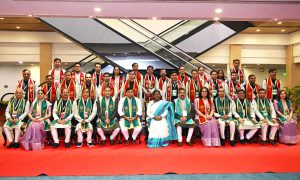
(By Dr. P.K. Purohit, Professor and Dean of Sciences at NITTTR, Bhopal, and contributed as a Scientist in Indian Antarctic Scientific Expedition)
Special on National Space Day on August 23
India’s journey into space is a saga of vision, courage, and relentless pursuit of the unknown. From the humble beginnings at Thumba in 1963 to the spectacular triumphs of Chandrayaan, Mangalyaan, and Aditya-L1, our missions have combined scientific brilliance with the excitement of exploration.
Each launch is not just a technological achievement—it’s a step into the mysteries of the cosmos, a thrilling quest that fuels our curiosity and inspires future generations. ISRO continues to push boundaries, turning dreams into data, and imagination into reality.
On August 23, 2025, India will observe its second National Space Day, featuring the inspiring theme – “Aryabhatta to Gaganyaan: Ancient Wisdom to Infinite Possibilities.”
Two years earlier, on August 23, 2023, the nation witnessed a historic moment when Chandrayaan-3 successfully landed near the Moon’s south pole at 6:04 pm IST. India became the first country to reach this unexplored region and the fourth to achieve a soft landing on the Moon, after Russia, USA, and China.
In recognition of this extraordinary achievement, Prime Minister Narendra Modi declared August 23 as National Space Day. As we celebrate National Space Day, we honor the scientists, engineers, and visionaries who make India’s space odyssey a beacon of hope, innovation, and wonder for the entire world.
India’s Moon Missions: A Journey of Determination
Chandrayaan-3, launched on July 14, 2023, from the Satish Dhawan Space Centre in Sriharikota, carried a lander and a rover (without an orbiter) and successfully entered lunar orbit on August 5, 2023, leading to a flawless landing. Prior to this, Chandrayaan-2 was launched in 2019 and placed its orbiter successfully in lunar orbit on August 20, but the Vikram Lander lost communication during its final descent on September 2, just 2.1 km above the Moon’s surface; although the lander and rover experiments could not be carried out, the orbiter remains active and continues to send valuable scientific data.
India’s first lunar mission, Chandrayaan-1, launched in 2008, made a significant discovery by detecting signs of water on the Moon, and its Moon Impact Probe landed on November 14, 2008, making India the fourth country to plant its flag on the lunar surface; the orbiter completed over 3,400 orbits before contact was lost in August 2009.
\
Foundations of India’s Space Programme
India’s journey in space science began under the visionary leadership of Dr. Homi Jehangir Bhabha and Dr. Vikram Sarabhai, with the establishment of the Indian National Space Research Committee in 1962, which later evolved into the Indian Space Research Organisation (ISRO) on 15 August 1969.
In 1972, the Government of India formed the Space Commission and Department of Space, bringing ISRO under its jurisdiction. From launching early rockets on bicycles to achieving lunar landings, ISRO has emerged as a global space leader. The journey began with the first launch at Thumba Equatorial Rocket Launching Station in Kerala on 21 November 1963, using the American-made Nike Apache sounding rocket.
Key milestones
Key milestones include the 1975 launch of Aryabhatta, India’s first indigenous satellite; the 1980 success of SLV-3 placing the Rohini Satellite into orbit; the development of INSAT, GSAT, Cartosat, and navigation satellite systems; and major missions such as Mangalyaan (Mars Orbiter Mission), Chandrayaan series, Aditya-L1, and the successful launch of over 425 satellites for both domestic and international clients.
Aditya-L1, India’s first solar observatory, was launched on 2 September 2023 aboard PSLV-C57. It successfully reached its designated halo orbit around the Sun-Earth L1 point on 6 January 2024. The mission is delivering vital insights into the Sun’s corona, solar plasma, and activity, contributing significantly to global space weather research.
Gaganyaan
Now ISRO is working on an important mission “Gaganyaan,” which is India’s first manned space mission which has now entered its final phase. For the mission, man will be sent into space at a low Earth orbit of 400 km and then brought back safely to Earth. If the mission is successful, India will join the countries that have launched crew spacecraft on their own. So far only America, Russia and China have been able to do this.
From the humble launch of Aryabhatta to the complex missions of Chandrayaan, Mangalyaan, Aditya-L1 & Gaganyaan, India’s space programme embodies the spirit of Atmanirbhar Bharat. Guided by the vision of its pioneers, India continues to transform ancient wisdom into infinite possibilities.







